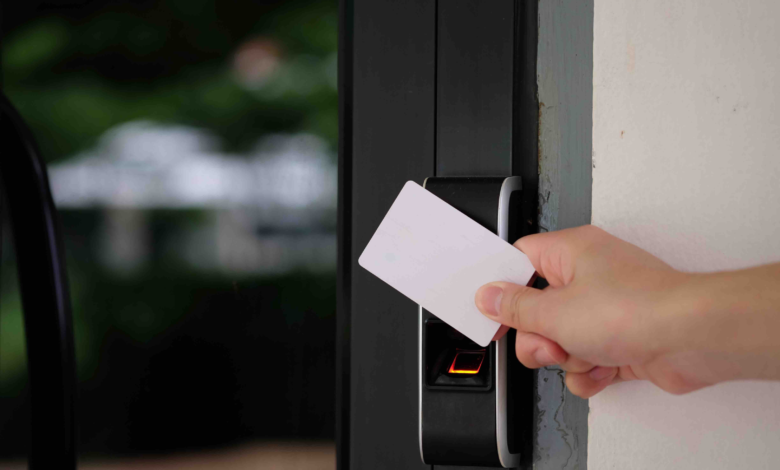Behind the Swipe: Exploring the Technology Behind Hotel Key Cards

Unlocking the door to your hotel room with a simple swipe of a card has become second nature for travelers around the world. But have you ever stopped to think about the technology behind those trusty hotel key cards? These little plastic wonders hold more than just access to your temporary home away from home – they are packed with fascinating technological advancements that have revolutionized the hospitality industry. In this blog post, we’ll take a peek behind the swipe and explore the evolution, inner workings, advantages, limitations, security concerns, and future innovations of hotel key cards. So grab your electronic keycard and let’s embark on an enlightening journey into the realm of Hotel Key Cards!
The Evolution of Hotel Key Cards
In the early days of hotel accommodations, metal keys were handed out to guests upon check-in. These traditional keys, while serving their purpose, posed several challenges. They were easily lost or misplaced, leading to potential security risks and inconvenience for both guests and staff.
As technology advanced, so did the need for a more efficient and secure method of granting access to hotel rooms. Enter the era of magnetic stripe cards. This innovation allowed hotels to encode guest information onto a magnetic strip on the back of a plastic card. With a simple swipe through a card reader attached to the door lock, guests could effortlessly gain entry to their rooms.
However, with time came new demands and expectations from travelers. The limitations of magnetic stripe cards became apparent – they were prone to wear and tear, susceptible to demagnetization from contact with other items like mobile phones or credit cards.
To address these shortcomings, radio frequency identification (RFID) technology emerged as the next frontier in key card evolution. RFID key cards use electromagnetic fields to wirelessly transmit data between an embedded chip in the card and an electronic reader at the door lock.
This breakthrough brought about contactless convenience – no longer did guests need to physically swipe their cards; instead, they simply had to hold them within close proximity of the reader for authentication purposes.
The adoption of RFID technology also opened doors (pun intended!) for additional functionalities beyond room access control. Hotels began integrating their key cards with other systems such as loyalty programs or cashless payment options within their premises.
The evolution of hotel key cards has not only enhanced security but also improved overall guest experience by streamlining check-in processes and offering added convenience during their stay.
How Do Magnetic Stripe Cards Work?
Magnetic stripe cards have been a staple in the hotel industry for decades. But have you ever wondered how these little plastic wonders actually work? Let’s take a closer look at the technology behind magnetic stripe cards.
At the heart of every magnetic stripe card is, well, a magnetic stripe! This thin strip of magnetically encoded data is typically made up of iron particles embedded in a plastic film. When swiped through a card reader, the stripes interact with sensors to transmit information to the system.
The encoding process involves arranging the iron particles in specific patterns along the length of the stripe. These patterns represent binary code that can be read and interpreted by card readers. Each bit of information on the magnetic stripe corresponds to different aspects such as room number, guest name or check-in/check-out dates.
To retrieve this information, card readers use electromagnetic induction. As you slide your key card through a reader, it generates an electrical current that interacts with the magnetic field produced by those tiny iron particles on your card’s stripe.
Once this interaction occurs, it translates into meaningful data that allows access control systems to grant or deny entry based on programmed parameters set by hotel management.
In addition to providing access control capabilities, magnetic stripes are also used for other purposes like loyalty programs or charging amenities directly to guests’ rooms during their stay. The versatility and ease-of-use make them popular among hotels worldwide.
While widely adopted due to their simplicity and affordability, magnetic stripe cards do have some limitations. They are susceptible to wear and tear over time which may result in unreliable readings at times. Additionally, they can easily be demagnetized if exposed too closely or directly near strong magnets like those found in purses or wallets containing credit cards with built-in magnets.
Despite these drawbacks, many hotels continue utilizing this tried-and-true technology while exploring newer alternatives like RFID and contactless options as well!
So next time you swipe your hotel key card, remember that behind its unassuming appearance lies a simple yet
The Rise of RFID and Contactless Technology
In recent years, there has been a significant shift in hotel key card technology with the rise of RFID (Radio Frequency Identification) and contactless systems. These advancements have revolutionized the way we access our hotel rooms and have made the check-in process faster and more convenient than ever before.
RFID technology uses radio waves to transmit data between a reader device and an electronic tag embedded in the key card. This allows for quick communication and eliminates the need for physical contact, making it ideal for touchless transactions. With just a wave or tap of the card, guests can effortlessly open their room doors without fumbling through their belongings.
One major advantage of RFID-based key cards is their enhanced security features. Unlike traditional magnetic stripe cards that are susceptible to cloning or demagnetization, RFID cards use encryption algorithms that make them much harder to duplicate or tamper with. Additionally, these smart cards can be easily deactivated remotely if lost or stolen, providing an extra layer of protection for both guests and hotels.
Moreover, contactless technology offers convenience beyond just room access. Many hotels now offer integrated payment options on these key cards, allowing guests to charge expenses directly to their rooms without carrying cash or credit cards around the property. This seamless integration saves time at checkout while ensuring a secure transaction process.
Although there are numerous advantages to using RFID-based key cards in hotels, there are also some limitations worth considering. For instance, if a guest loses their card during their stay without realizing it immediately, they may face potential security risks until they report its loss. Additionally, as with any technological system dependent on power sources such as batteries or electricity supply issues could potentially disrupt functionality.
As technology continues to evolve rapidly within the hospitality industry so do concerns about privacy and security implications associated with this innovation; however continuous efforts by manufacturers ensure robust encryption protocols safeguard personal information from unauthorized access helping put minds at ease when adopting new key card technologies.
With the increasing demand for contactless solutions, it’s no
Advantages and Limitations of Key Card Technology
Key card technology has revolutionized the hotel industry, offering numerous advantages for both guests and hotel staff. One major advantage is convenience. With a simple swipe or tap, guests can access their rooms without the hassle of traditional keys. This eliminates the need to carry around bulky keychains or worry about losing keys.
Another advantage is security. Hotel key cards are designed with encryption technology that makes them difficult to duplicate or tamper with. This provides peace of mind for guests knowing that their belongings are safe in their room.
In addition, key cards offer flexibility for hotels. Unlike physical keys, which require replacement if lost or stolen, key cards can be easily deactivated and reprogrammed as needed. This saves time and money for hotels while ensuring the safety of their guests.
However, there are some limitations to consider with key card technology. One limitation is reliability. Occasionally, technical glitches may occur causing issues with accessing rooms or demagnetization of cards. While these instances are rare, they can still cause inconvenience for both guests and hotel staff.
Furthermore, some individuals may have difficulty using key cards due to physical limitations such as arthritis or poor eyesight. In such cases, alternative options such as mobile apps or biometric systems should be available to accommodate all guests’ needs.
Despite its limitations, the advantages of key card technology outweigh any drawbacks it may have in terms of convenience and security in the hospitality industry.
Security Concerns and Solutions
When it comes to hotel key cards, security is a top concern. After all, these cards grant access to guests’ personal spaces and belongings. With the evolution of technology, new security risks have emerged, but so too have innovative solutions.
One common concern with traditional magnetic stripe cards is their vulnerability to cloning or unauthorized copying. Thieves can easily obtain the necessary information from a card’s magnetic strip and create duplicate cards without detection. To combat this issue, hotels often implement encryption techniques that scramble the data on the magnetic strip, making it virtually impossible for thieves to replicate.
Another security risk with key card technology involves lost or stolen cards. If someone finds a misplaced card or steals one from a guest’s room, they could potentially gain unrestricted access to secure areas within the hotel. To address this challenge, many hotels now use RFID (Radio Frequency Identification) technology in their key cards. These contactless cards require close proximity for activation and are individually programmed with unique identifiers that cannot be easily duplicated.
However, even RFID has its limitations. Hackers equipped with specialized equipment can intercept radio signals and clone an RFID card remotely without physical contact with it. As a result, hotels have begun implementing additional security measures such as two-factor authentication or biometric verification systems like fingerprint scanning alongside RFID technology.
To further enhance security protocols, some hotels are exploring blockchain-based solutions for their key card systems. Blockchain offers decentralized storage of information that is highly resistant to tampering or hacking attempts due to its transparent nature and cryptographic algorithms.
While no system is entirely foolproof against determined criminals, continuous advancements in technology provide opportunities for increased security measures in hotel key card systems.
Future Innovations in Hotel Key Cards
As technology continues to evolve at a rapid pace, it’s no surprise that hotel key card systems are also advancing. The future holds exciting possibilities for the next generation of hotel key cards.
One area of innovation is the integration of mobile devices with keyless entry systems. Many hotels have already started implementing smartphone apps that allow guests to bypass traditional key cards altogether. By using their smartphones as digital keys, guests can seamlessly unlock their rooms and access other hotel amenities with just a tap on their screen.
Biometric authentication is another futuristic trend in hotel key card technology. Instead of relying solely on physical cards or digital keys, biometrics like fingerprint recognition or facial scanning could provide even more secure and convenient access to guestrooms.
In addition, advancements in Internet of Things (IoT) technology are set to revolutionize the entire guest experience. Imagine walking into your room and having personalized settings automatically adjusted based on your preferences – from temperature control to lighting ambiance – all thanks to IoT-connected key cards.
Furthermore, there is ongoing research into incorporating sustainable materials in the production of hotel key cards. As environmental concerns grow, industry leaders are exploring options such as biodegradable or recycled materials for these essential hospitality tools.
While these innovative technologies offer great potential for enhancing convenience and security, it’s important for hotels to carefully consider data privacy and cybersecurity measures when implementing them.
The world of hotel key cards is constantly evolving, driven by technological advancements and changing consumer needs. Whether it’s through contactless RFID systems or cutting-edge mobile phone integrations, one thing remains certain: hoteliers will continue seeking ways to enhance guest experiences while ensuring utmost security.
So next time you swipe your trusty plastic card upon check-in at a hotel, take a moment to appreciate the behind-the-scenes technology that makes your stay possible – because beyond its simple appearance lies an intricate system designed specifically for your comfort and safety!



